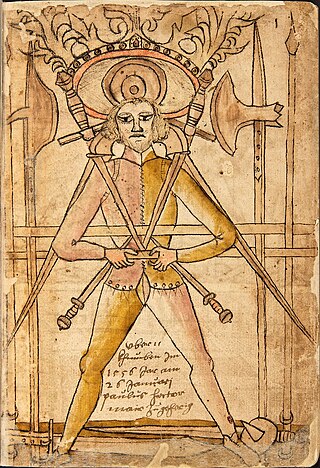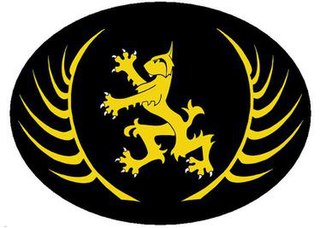
A rapier or espada ropera is a type of sword used in Renaissance Spain to designate a sword with a straight, slender and sharply pointed two-edged long blade wielded in one hand. It was widely popular in Western Europe throughout the 16th and 17th centuries as a symbol of nobility or gentleman status.

Fiore Furlano de Cividale d'Austria, delli Liberi da Premariacco was a late 14th century knight, diplomat, and itinerant fencing master.

Swordsmanship or sword fighting refers to the skills and techniques used in combat and training with any type of sword. The term is modern, and as such was mainly used to refer to smallsword fencing, but by extension it can also be applied to any martial art involving the use of a sword. The formation of the English word "swordsman" is parallel to the Latin word gladiator, a term for the professional fighters who fought against each other and a variety of other foes for the entertainment of spectators in the Roman Empire. The word gladiator itself comes from the Latin word gladius, which is a type of sword.

Johannes Liechtenauer was a German fencing master who had a great level of influence on the German fencing tradition in the 14th century.

Historical European martial arts (HEMA) are martial arts of European origin, particularly using arts formerly practised, but having since died out or evolved into very different forms.
Martial arts manuals are instructions, with or without illustrations, specifically designed to be learnt from a book. Many books detailing specific techniques of martial arts are often erroneously called manuals but were written as treatises.

The term Italian school of swordsmanship is used to describe the Italian style of fencing and edged-weapon combat from the time of the first extant Italian swordsmanship treatise (1409) to the days of classical fencing.

Joachim Meyer was a self-described Freifechter living in the then Free Imperial City of Strasbourg in the 16th century and the author of a fechtbuch Gründtliche Beschreibung der Kunst des Fechtens first published in 1570.

Francesco Ferdinando Alfieri was a master of fencing of the 17th century. He was a representative of the Venetian school of fencing and “Maestro D’Arme” to the Accademia Delia in Padua in 1640. Alfieri was originally from Padua, which at that time was the territory of the Venetian Republic.
De Arte Gladiatoria Dimicandi was written by Italian fencing master Filippo Vadi between 1482 and 1487. It consists of an opening prologue describing the art of fencing followed by colored plates illustrating specific techniques for the longsword, dagger, pollaxe, spear and club. While much of what he describes closely follows the work of Fiore dei Liberi, author of Flos Duellatorum, Vadi's work also differs in some respects, including his footwork and several original techniques of his own.
Bolognese Swordsmanship, also sometimes known as the Dardi school, is a tradition within the Italian school of swordsmanship which is based on the surviving fencing treatises published by several 16th century fencing masters of Bologna, As early as the 14th century several fencing masters were living and teaching in the city: a maestro Rosolino in 1338, a maestro Nerio in 1354, and a maestro Francesco in 1385.

Alfred Hutton FSA was a British Army officer, antiquarian and writer. Serving during the Victorian era in the 1st King's Dragoon Guards, he played a major role in the revival of historical fencing in England, together with fellow fencers Egerton Castle, Ernest Stenson-Cooke, Sir Frederick Pollock and Walter Herries Pollock.
Giuseppe Radaelli was a 19th-century Milanese fencing master and soldier. Often regarded as "the father of modern sabre fencing", his sabre fencing principles were popularised throughout Europe via his students such as Luigi Barbasetti, Ferdinando Masiello, Salvatore Pecoraro, and Carlo Pessina.
The oldest surviving manual on western swordsmanship dates back to the 14th century, although historical references date fencing schools back to the 12th century.
Nova Scrimia is an Italian organisation which promotes the teaching of the Italian school of swordsmanship, of stick fencing, of short range fencing (dagger) and of unarmed fencing from the documented period that goes from the 15th century to the 20th century. Nova Scrimia is currently represented in Italy and other European countries, in USA and in Mexico.
Italian martial arts include all those unarmed and armed fighting arts popular in Italy between the Bronze age until the 19th century AD. It involved the usage of weapons. Each weapon is the product of a specific historical era. The swords used in Italian martial arts range from the Bronze daggers of the Nuragic times to the gladius of the Roman legionaries to swords which were developed during the renaissance, the baroque era and later. Short blades range from medieval daggers to the liccasapuni Sicilian duelling knife.
Chivalry Bookshelf was a small press based in the United States founded by Brian R. Price which published booklets and books from 1992 to 2007. It was most notable for its contributions to the Society of Creative Anachronism and the early historical fencing movement and for a dispute about plagiarism and nonpayment of royalties in 2011-12.

Schola Gladiatoria (SG) is a historical European martial arts (HEMA) group based in Ealing, west London, Great Britain, founded in 2001 and led by Matt Easton. It provides organized instruction in the serious study and practice of historical European swordplay. Schola seeks to be consistent with the methodology of the ancient European fencing schools by combining scholarship and research into the teachings of the historical masters, with the practical knowledge gained through solo and partnered drilling, and free play (sparring).

Laurentius Guild (Laurentiusgildet) is a historical European martial arts group headquartered in Aarhus, Denmark with chapters in Nyborg and Vordingborg. Its membership consists of academic researchers specializing in fencing with a focus on the 14th and 15th centuries.

The Renaissance Sword Club is a historical European martial arts group based in London, South East of England and Brittany, France. It was founded in 2013 by Rob Runacres. Its primary aim is the research and recreation of European swordsmanship of the sixteenth and seventeenth centuries, specifically those concerned with the rapier and spada da lato, as well as their companion weapons such as the dagger, cloak, buckler and rotella. Members have also pursued interests outside of the core curriculum in to staff weapons, longsword and small sword.











